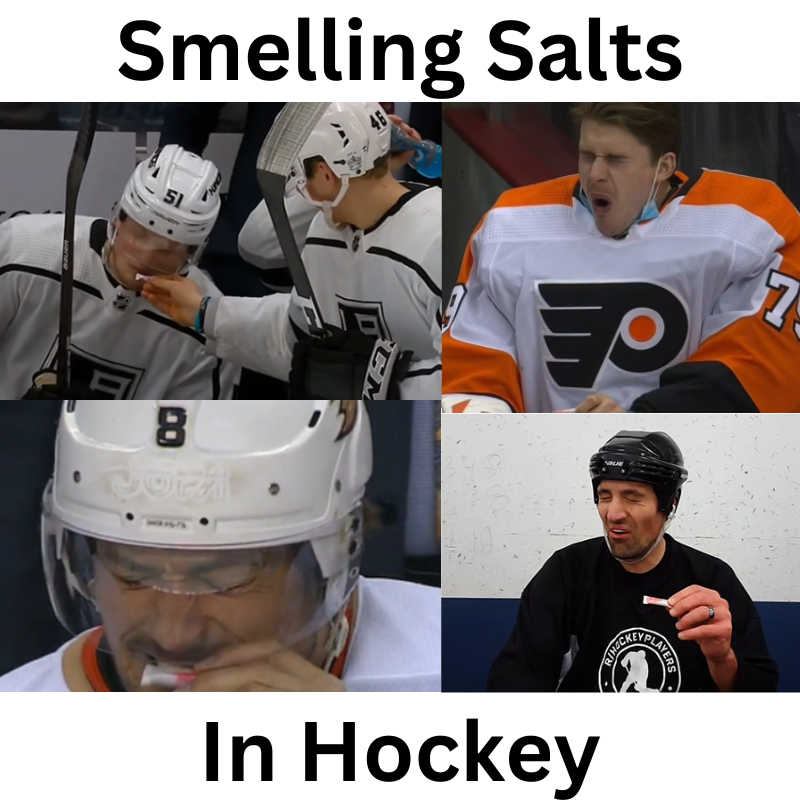In the electrifying world of hockey, amidst the clang of sticks and the thunder of skates, there exists a peculiar ritual that has intrigued fans and players alike for generations – the use of smelling salts. These seemingly innocuous capsules hold a potent power, capable of jolting a player’s senses to life with just a single sniff.

But what exactly are they, why do hockey players swear by them, and what effects do they have on the body? Let’s dive into the fascinating world of smelling salts.
What are Smelling Salts?
Contrary to their name, smelling salts aren’t salts in the traditional sense. Rather, they are small, sealed capsules containing a mixture of ammonia and water. When the capsule is crushed or broken open, the ammonia vaporizes, releasing a pungent odor that can instantly stimulate the olfactory nerves.
Why Do Hockey Players Use Smelling Salts?
In the fast-paced, physically demanding arena of hockey, players are constantly pushing their bodies to the limit. Fatigue, impacts, and adrenaline can sometimes dull the senses, leading to moments of mental fog or sluggishness. This is where smelling salts come into play.
Hockey players often use smelling salts as a quick pick-me-up, especially during intense moments of play or when they need to shake off the cobwebs after a hard hit. The sharp, ammonia-rich scent acts as a powerful stimulant, triggering an immediate physiological response that can increase alertness, focus, and energy levels within seconds.
Moreover, the psychological aspect of smelling salts cannot be overlooked. The ritual of inhaling the sharp scent can serve as a mental cue, signaling to the player that it’s time to ramp up their intensity and focus on the task at hand. In a sport where split-second decisions can make all the difference, this mental boost can be invaluable
The Effects of Smelling Salts on the Body:
The primary active ingredient in smelling salts is ammonia, a compound known for its strong, pungent odor and potent stimulating effects. When inhaled, the ammonia vapor triggers an involuntary reflex known as the “gasp reflex.” This reflex causes an immediate increase in breathing rate and heart rate, leading to a surge of oxygenated blood flow to the brain and muscles.
As a result, the player experiences a sudden rush of alertness and heightened awareness, accompanied by a temporary boost in energy and focus. This can be especially beneficial during moments of fatigue or when a player needs to quickly shake off the effects of a collision or injury.
However, it’s essential to recognize that while smelling salts can provide a temporary performance boost, they are not without risks. Prolonged or excessive use of smelling salts can irritate the respiratory system, cause nasal discomfort, and potentially lead to dependency or habituation.
Conclusion: In the high-stakes world of hockey, where every second counts and split-second decisions can determine the outcome of a game, smelling salts have earned their place as a trusted ally for players seeking an extra edge. With their ability to jolt the senses to life and sharpen focus in an instant, these small but mighty capsules have become an integral part of the game-day ritual for many athletes.
Yet, like any powerful tool, smelling salts must be used judiciously and with caution. While they can provide a temporary performance boost when used responsibly, players and coaches must be mindful of the potential risks and avoid excessive reliance on these potent stimulants.
In the end, smelling salts serve as a potent reminder of the lengths to which athletes are willing to go in pursuit of victory – a testament to the unyielding spirit and determination that define the heart of the game we love.
Thanks for your time. Please leave comments and suggestions below.




